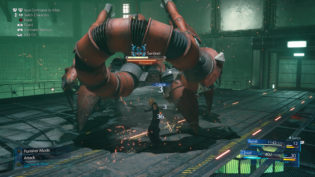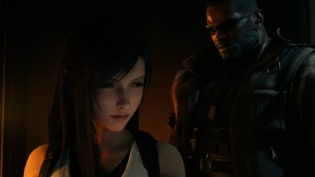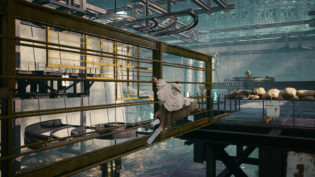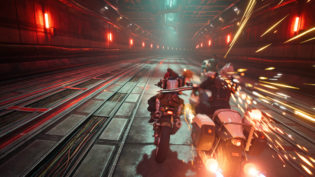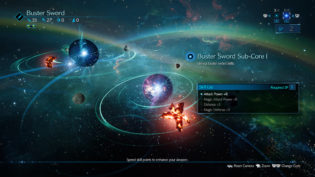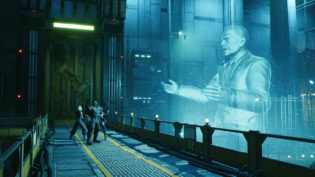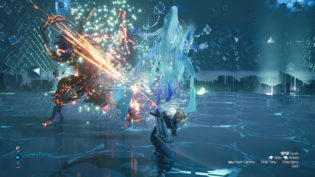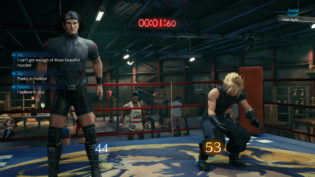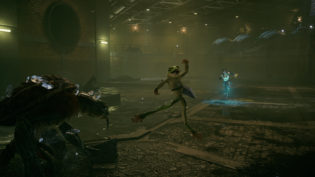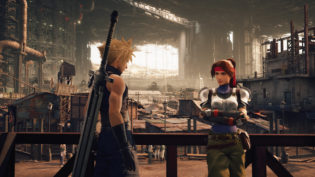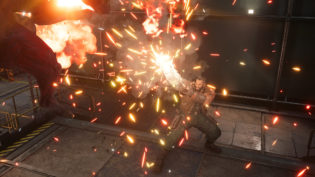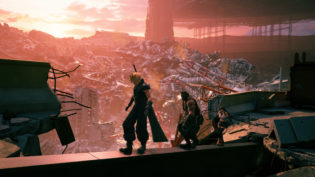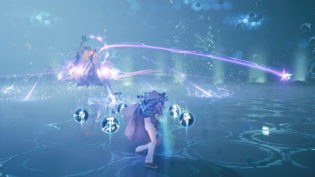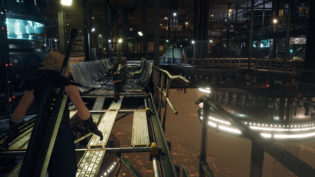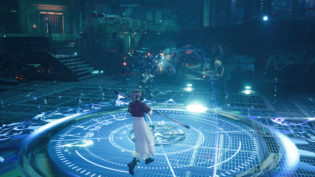The incredible hype for a remake of Final Fantasy VII has always felt odd to me. Partially because I didn’t care that much about the original game, but also because I couldn’t even picture how a classic jRPG could be remade, other than by doing it in the exact same way but with better visuals. Which sounded pointless. But the remake did happen after years of speculation and a surprise announcement. And it went in a rather unexpected direction. For one, “Remake” seems to be the actual name for this game, which is the first of several entries to redo the story of the original Final Fantasy VII. And if that’s not weird enough, the gameplay has been drastically redone too. What is most surprising to me, though, is that for how much respect rather than enjoy the original, I loved playing Remake.
So what is included in the Final Fantasy VII Remake, and specifically the updated Intergrade release? As far as the story goes, Remake recreates the first act of Final Fantasy VII – the events in the city of Midgar. I personally consider this to be the strongest part of the original anyway, so it was interesting to see this whole section, that originally takes around 3-5 hours, greatly expanded into a 30 hour standalone game. But the title does it wonderfully, making every character better, every scene more interesting and making you believe in this world and its story more than you did in the entirety of the original FF VII.
But this expansion of the story also meant that some sequences are now longer and have more details and some are entirely brand new, but are based on the concepts that were touched upon in the older Compilation of Final Fantasy VII sub-series of the franchise. So, titles like Crisis Core, Before Crisis, Dirge of Cerberus and the Advent Children movie have a lingering influence on the plot of Remake in addition to just the original title. Which is where basically all of the Intergrade content comes in. Intergrade re-release of the game, apart from many visual and gameplay tweaks, added Episode INTERmission – a separate little story DLC that does not have any direct comparison in the original game, but is full to the brim with these expanded universe elements and characters.
The weird thing about it, and one of the main criticisms of Remake I’ve heard, is the fact that Remake basically knows that it’s a remake and works almost as a parallel universe sequel to the original game, rather than a recreation. Don’t let this discourage you at this point – while we don’t know yet just how far the story may stray in the future remake entries (like the already announced Rebirth), the knowledge of the original game isn’t required to enjoy Final Fantasy VII Remake. There will be a couple of mainly minor odd moments that have absolutely no in-game explanation, but you may treat them as a sequel-bait and enjoy the rest. This does influence the main plot when compared to the original, of course, and there are many moments that hint at the, essentially, main twist of the original game that used to be at this point of the story only very subtly hinted upon. But again – not a deal breaker if you don’t know the original. I was utterly confused at many of the stupidly edgy elements of Episode INTERmission, as I’ve never played Dirge of Cerberus, but I understood enough and enjoyed the story.
As I’ve mentioned, though, while the story follows mostly the same storyline with a few wild turns, the gameplay is a completely different beast. Square Enix decided to continue the pursuit of the odd mix of a more classic turn-based/Active-Time battle systems with fully real time action RPG that didn’t really work in Final Fantasy XIII and especially Final Fantasy XV. And last time I said that I’d rather see them move closer to the tactical ideas from XII with gambits and nuanced customization of the team behavior, which was extremely fun. But they persisted in their vision and I’m glad they did – Final Fantasy VII Remake combat is actually pretty good. It still falters at being a great example of either hack and slash action RPG or a faster paced jRPG tactics title, but they’re so close to figuring it out, you can feel it in INTERmission, where they’re getting ever closer to cracking this puzzle.
The concept for the battle system is pretty simple – you have moves like you would in a hack and slash action RPG, like freely moving the character around, blocking, dodging and attacking. And you can do all of that so quickly that while there technically is a behind the scenes “turn order” thing happening, the game prioritizes responsiveness, unlike XV or recent example from a different developer – Scarlet Nexus, – where animations and turns take priority leading to what feels as “unresponsive” combat. But you still have the ATB gauge that let’s you do any actions besides the basics, like using abilities, spells and items, as long as it’s filled to a required amount. Which means that the game still has enough classic elements to even be able to have a “Classic” difficulty mode (available for Easy and Normal as a modifier in Intergrade), where all basic actions are automated and you control the party only via the menu.
What’s especially fun about this approach is that every single character feels different. Most of the time you explore only as Cloud, but can switch to any character in your party during the combat and all of them require a completely different approach. To the point where characters like Yuffie or Tifa do feel almost like a character from a modern Ys title, because of how fast they can build the ATB and do dodging and blocking, zipping across the battlefields and juggling enemies in the air. The game in several ways reminded me of Parasite Eve 2, a title that I love, for this similar approach of taking a more “classic” jRPG and making it into something that feels both familiar and yet entirely fresh. So I can only hope that Rebirth does things even better.
Other than the combat, if you have played the original game, a lot of the elements will feel familiar. Materia is still extremely important, though this time there are less active ability materias to choose from and a bigger focus on either spells, modifiers and passive boosts or move improvements. That’s because a far bigger focus now lies with the weapons available for the characters. Each weapon can be upgraded and has a unique ability that you can permanently learn by using it. And every weapon is made to serve a particular playstyle and party configuration you have, instead of being a direct upgrade. Also, materia no longer spawns a new one when maxed out, so some of the more rare ones are very limited and summons are reserved for a separate equipment slot and cannot grow at all. Materia itself no longer adds any passive negative or positive effects when attached, since the uniqueness of gear is there to serve the same purpose. Oh and the summons now work closer to how they did in XV, so you can’t just spam them.
Sadly, the love of the original FF VII for mini-games strikes in Remake again. And while in this title specifically most of the mini-games were at least not terrible and some are even really fun, there are some stinkers and some that have a great concept but are done really poorly. It was especially odd that a tiny wonderful rhythm game moment that has timed colour coded button presses didn’t update the colour coding for multiplatform re-release of the game. So even if you play with an Xbox controller, you do get the correct button prompts, but also the original Playstation button colour which is very confusing for things like, say Triangle and A buttons which are both green but are on the opposite sides to each other. And also while I did love most of the expanded story, I did feel like the game started to overstay its desire to make more of everything by the end and some of the sections could’ve been made shorter or just simply cut and the game would’ve only been better.
The PC port of the game, as it is at the moment of me playing it, is acceptable, but not great. It’s kinda shocking, since several previous Square Enix Final Fantasy releases were great, but this one, despite using Unreal Engine 4, hasn’t been treated well as a port. There are very few settings, which is especially egregious for lots of very bright flashing the game has in Intergrade release that cannot be toned down. Game has occasional issues and the infamous UE4 shader compilation stutter. It was worse at launch, where a dynamic resolution was forced with no option to disable it, but by now this seems to have been disabled. Also the game can just fill the screen with pure white if you pause the game sometimes and the only way to fix that is to pause and unpause, try photo mode and do weird stuff until it goes away.
Even though I was several years late to play Final Fantasy VII Remake for myself and expected that I will enjoy this game more than I do the original, I did not expect to love it as much as I did. It tells a pretty good story much better than the original ever did, making it so much better. It plays really well. It has a fun approach to new game plus, so don’t worry if you miss anything accidentally, by the way, the way you can replay stuff in the game is quite well done. It’s great for those who played the original and for those who didn’t. The soundtrack of the original that was already fantastic is made even better. And it’s just a lot of fun to play. Not all of it. And Hard mode seems rude. But most of my grievances with this title are very minor and I wholeheartedly recommend playing Final Fantasy VII Remake in its Intergrade release.


